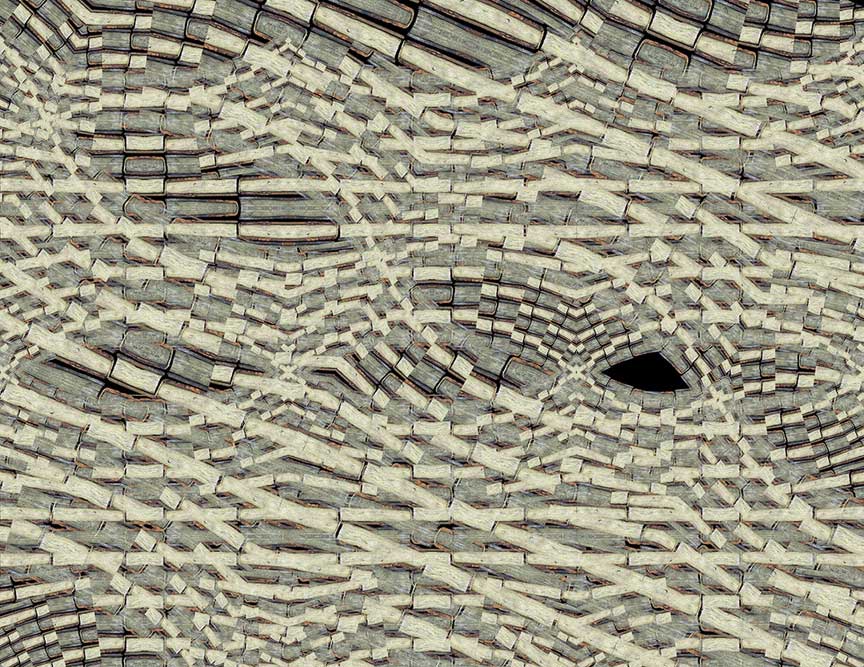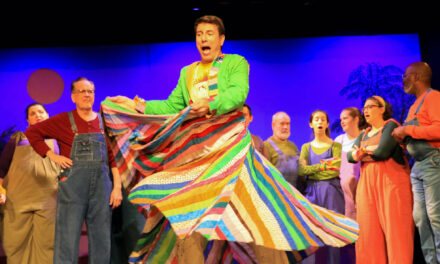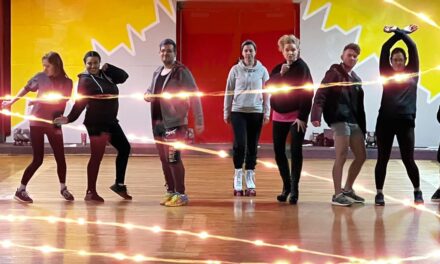PYRO Gallery
Review by Keith Waits
Entire contents are copyright © 2013 Keith Waits. All rights reserved.
After a period working in entirely abstract digital compositions, artist Keith Auerbach has reacquired the representational, after a fashion. There is a studied, analytical quality to his work currently on exhibit at PYRO Gallery. A sensitivity to human experience was a defining characteristic of his earlier Cartier-Bresson inspired photographs: a sense of humor and playfulness always a feature of his observational eye; but the abstract compositions that have overtaken his artistic sensibility still capture the psychological complexity of human understanding.
 |
| Gutenberg Book, archival inkjet print, 2012. |
Now the artist has dropped the camera altogether, at least for the time being. His source images are digital scans of manuscript pages from several sources, pages of music, a geometry text and, most notably, rare editions of Victor Hugo’s Les Miserables dated 1860, and a 15th Century manuscript thought to have originated with the Medici family. Verbiage from the pages is visible and even at times legible, although the meaning of the text is limited to providing an identifier of the narrative contained therein. The viewer can discern the name of Hugo’s famous hero, “Jean Valjean,” but any theme or action in the narrative seems to be largely irrelevant to Mr. Auerbach’s intentions. He again uses the images as a basic supply with which to explore shape, movement and texture through digital constructions that use state-of-the-art technology to now conjure more traditional associations.
 |
| Gutenberg Book pages – 2 |
Mr. Auerbach’s previous bodies of work were much more abstract and characterized by vivid color and organic shapes. Now he has reintroduced representational elements and, for the most part, restricted his color palette to a mostly monochromatic and analogous range of warm, natural tones that echo the aged patina of the pages. A few of the pieces share some of the amorphous shapes of the previous generation of digital abstracts, but the strongest work here takes a different direction. Instead of a riot of splattered, organic forms, the compositions are constructed from severely geometric shapes and repetitive structures. These range from the simple and elegant spirals of kinetic angles that result in the leg-like shapes of “Gut Dance,” to the almost overwhelmingly dense texture of “Gutenberg Book.” The latter image consists of scans of each end of the fragile volume – two similar but distinct visual components that are repeated in a format so tight that it creates visual layers of form and texture, fashioning an abstraction from the representational.
 |
| Les Miserables – The Derrick, archival inkjet print, 2012. |
Dimensionality is largely absent, although the exhaustive layering of scans build up considerable depth, and at least one example, “Les Miserables–1,” is characterized by a 3-D effect, as if the pages had been “pinched” by a human hand to form bloom-like contours. A few pieces utilize the manipulated scans as elements on long, vertical paper that intentionally connote Japanese scrolls; and others organize the aforementioned shapes into overt facsimiles of Asian characters. Taken together with the visual quality of papyrus or rice paper emulated, perhaps unconsciously, by much of the work, the Asian elements join with Gutenberg (German) printing and Victor Hugo (French), and the connection to other cultures is complete.
The range of format and compositional structures reveals the curiosity and enthusiasm for process that leads the artist in the development of this work, yet there is a variation in the impact through the course of viewing the large volume of work. All are fascinating, but the strongest among them are not merely exercises but mysterious and suggestive of things of which perhaps even the artist is not always cognizant. Like any good archeologist, Mr. Auerbach is excavating deeper understanding than the pleasures of form and texture.
The overall impact is a merging of modern technology with a sensibility tied to the past. Not a nostalgia, rather something more archealogical, as if Mr. Auerbach’s playful approach to his digital manipulation has suddenly unearthed an ancient sarcophagus filled with knowledge of a civilization vanished from the earth’s face. The modern, digital voice speaks to the aged, decaying voice of the antique printed page.
The Next Call: LetterForms
February 21 – March 30, 2013
PYRO Gallery
909 East Market St.
Louisville, KY 40202
502-587-0106
Thursday-Saturday, 12-6 p.m.




